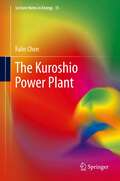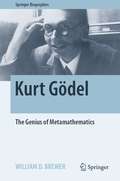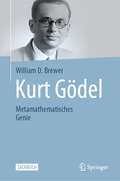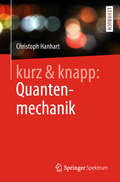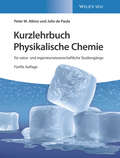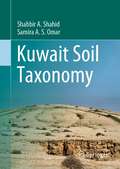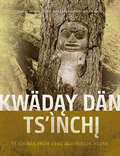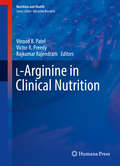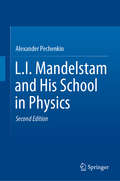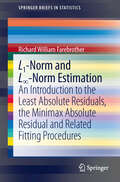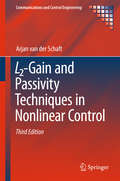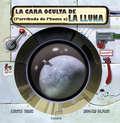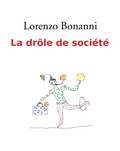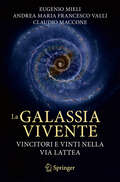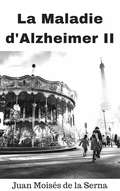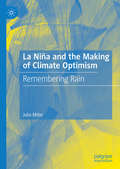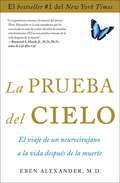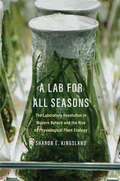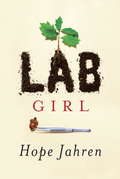- Table View
- List View
Kupffer Cells: Methods and Protocols (Methods in Molecular Biology #2164)
by Myriam Aouadi Valerio AzzimatoThis volume provides a complete overview of kupffer cell biology, from isolation to phenotyping. Chapters guide readers through methods and protocols on phenotyping, including RNA sequencing, Mass cytometry and 3D microscopy, as well as gene manipulation in vivo, and disease models from fatty liver disease to cancer. Written in the highly successful Methods in Molecular Biology series format, chapters include introductions to their respective topics, lists of the necessary materials and reagents, step-by-step, readily reproducible laboratory protocols, and tips on troubleshooting and avoiding known pitfalls. Authoritative and cutting-edge, Kupffer Cells: Methods and Protocols aims to ensure successful investigation of this growing field.
The Kuroshio Power Plant
by Falin ChenBy outlining a new design or the Kuroshio power plant, new approaches to turbine design, anchorage system planning, deep sea marine engineering and power plant operations and maintenance are explored and suggested. The impact on the local environment, particularly in the face of natural disasters, is also considered to provide a well rounded introduction to plan and build a 30MW pilot power plant. Following a literature review, the six chapters of this book propose a conceptual design by focusing on the plant's core technologies and establish the separate analysis logics for turbine design and the relay platforms. This is tempered against the ecological impact of both the construction and operation of the plant. These proposed technologies and plans can be further applied to power generation in other waters such as the Gulf Stream, the East Australian Current the Humboldt Current and the East Africa Coastal Current. Engineers, students and industry professionals are provided with a solid introduction to power plant technology as well as a design with specific real world applications
Kurt Gödel: The Genius of Metamathematics (Springer Biographies)
by William D. BrewerDuring his lifetime, Kurt Gödel was not well known outside the professional world of mathematicians, philosophers and theoretical physicists. Early in his career, for his doctoral thesis and then for his Habilitation (Dr.Sci.), he wrote earthshaking articles on the completeness and provability of mathematical-logical systems, upsetting the hypotheses of the most famous mathematicians/philosophers of the time. He later delved into theoretical physics, finding a unique solution to Einstein’s equations for gravity, the ‘Gödel Universe’, and made contributions to philosophy, the guiding theme of his life. This book includes more details about the context of Gödel’s life than are found in earlier biographies, while avoiding an elaborate treatment of his mathematical/scientific/philosophical works, which have been described in great detail in other books. In this way, it makes him and his times more accessible to general readers, and will allow them to appreciate the lasting effects of Gödel’s contributions (the latter in a more up-to-date context than in previous biographies, many of which were written 15–25 years ago). His work spans or is relevant to a wide spectrum of intellectual endeavor, and this is emphasized in the book, with recent examples. This biography also examines possible sources of his unusual personality, which combined mathematical genius with an almost childlike naiveté concerning everyday life, and striking scientific innovations with timidity and hesitancy in practical matters. How he nevertheless had a long and successful career, inspiring many younger scholars along the way, with the help of his loyal wife Adele and some of his friends, is a fascinating story in human nature.
Kurt Gödel: Metamathematisches Genie
by William D. BrewerZu seinen Lebzeiten war Kurt Gödel außerhalb der Fachwelt der Mathematiker, Philosophen und theoretischen Physiker kaum bekannt. Zu Beginn seiner Karriere schuf er beeindruckende Arbeiten zur Vollständigkeit und Beweisbarkeit formaler logischer Systeme, die zu seiner Dissertation und seiner Habilitations-schrift wurden und ihn unter Fachleuten weltberühmt machten. Seine Unvoll-ständigkeitssätze läuteten das Ende der formal-logischen Programme der Logizisten (Russell et al.) und der Formalisten (Hilbert et al.) ein. Später erzielte er auch signifikante Ergebnisse in der Mengenlehre. Nach seiner Emigration in die USA (Princeton), widmete er sich mehr der Philosophie, dem Leitmotiv seines Lebens, und er fand auch eine einzigartige Lösung zu Einsteins Feld-gleichungen der Gravitation, sein “Gödel-Universum“. Dieses Buch beschreibt sowohl den Gödel, der ein genialer Wissenschaftler war, und der gewagte und neuartige Hypothesen zu den Fundamenten der Mathe-matik und Physik hervorbrachte, ‒ als auch den Gödel, der ein perfekter Rationalist war, aber sein Alltagsleben nur mit Mühe meistern konnte und zeitlebens unter Depressionen, Angstneurosen und Hypochondrie litt. Ein Leben voller Paradoxen, in dem er trotz all seiner psychischen Probleme Beachtliches leistete und zu einem Vorbild für viele jüngere Wissenschaftler wurde. Das Buch liefert den Kontext zu seinen Errungenschaften, die ein verblüffend breites Spektrum intellektueller Unternehmungen darstellen, und zu seiner zunehmenden Geisteskrankheit; und es zeigt, wie er eine lange und erfolgreiche Karriere mit Hilfe seiner loyalen Ehefrau Adele und einigen seiner Freunde durchlaufen konnte. Dies ist eine faszinierende Geschichte der wissen-schaftlichen Genialität und der menschlichen Natur.
kurz & knapp: Das Wichtigste auf unter 150 Seiten
by Christoph HanhartIn diesem Buch wird Ihnen der Vorlesungsstoff zur Quantenmechanik 1 auf weniger als 150 Seiten präsentiert. Der Autor konzentriert sich dabei auf das Wesentliche: Er zeichnet einen klaren roten Faden, behandelt längere Rechnungen erst in Aufgaben zu den jeweiligen Kapiteln und verzichtet auf Historisches. Mit relativ kurzen und modular aufgebauten Kapiteln ist das Buch sowohl zum Nachschlagen als auch zum Selbststudium geeignet. Jedes Kapitel beginnt mit einem kurzen Überblick über das jeweilige Thema und zentralen Fragen, die im Hauptteil adressiert werden. Den Abschluss jedes Kapitels bilden Zusammenfassungen, die die Fragen vom Anfang wieder aufgreifen und in kompakter Form beantworten.
Kurzlehrbuch Physikalische Chemie: für natur- und ingenieurwissenschaftliche Studiengänge
by Peter W. Atkins Julio de PaulaMit seinem lebendigen und anschaulichen Stil sowie einer immer weiter verfeinerten Didaktik hat Peter Atkins das Lernen und Lehren in der Physikalischen Chemie revolutioniert. Sein Stil ist unverwechselbar - und unerreicht. Die vollständige überarbeitete Neuauflage umfasst die kompletten Grundlagen des Fachs für Bachelor-Studenten und Nebenfächler und zeigt spannende Verbindungen zu anderen Gebieten der Chemie sowie zur Physik und Biologie auf. Kurz und gut: Der 'kleine' Atkins ist und bleibt ein Muss für jeden Einsteiger in die Physikalische Chemie.
Kuwait Soil Taxonomy
by Shabbir A. Shahid Samira A. OmarThis book provides guidelines to key soil taxa in the deserts of Kuwait and guidance to associated procedures for laboratory analyses of soils, leading to land use planning on informed decisions. Soils are essential to provide food, feed, and fiber in addition to multiple ecosystem services that sustain life on earth. To achieve the above services sustainably, it is essential to use soils rationally based on their potential for specific uses. This requires establishing national soil classification systems to assess soils locally and to provide guidance to other countries where similar soils may be occurring. Once soil classification is established, it becomes easier to adopt technologies established on similar soils and environmental conditions without conducting long-term and expensive experimental trial. The taxa are established based on soil’s morphological, physical, chemical, and mineralogical properties and climatic factors. It offers opportunities to maintain future soil surveys and their correlation to the soils of Kuwait. The book is useful in other arid region countries where similar soil and environmental conditions are existing, such as Bahrain, Oman, Qatar, and Saudi Arabia. The book also has international relevance, as it was prepared by extracting definitions from USDA-NRCS keys to soil taxonomy, and sections related to soils of Kuwait are added in the book. The book is a unique and excellent addition to the international soil literature.
Kwäday Dän Ts'ìnchi: Teachings from Long Ago Person Found
by Richard J. Hebda Sheila A. Greer Alexander P. MackieOn a late summer day, many years ago, a young man set out on a voyage through the mountains. He never reached his destination. When his remains were discovered by three British Columbia hunters, roughly three hundred years after he was caught by a storm or other accident, his story had faded from even the long memory of the region's people. First Nations elders decided to call the discovery Kwäday Dän Ts'ìnchi—Long Ago Person Found. The discovery of the Kwäday Dän Ts'ìnchi man raised many questions. Who was he and how did he die? Where had he come from? Where was he going, and for what purpose? What did his world look like? But his remains, preserved in glacial ice for centuries, offered answers, too—as did the traditional knowledge and experience of the Indigenous peoples in whose territories he lived and died. In this comprehensive and collaborative account, scientific analysis and cultural knowledge interweave to describe a life that ended just as Europeans were about to arrive in the northwest. What emerges is not only a portrait of an individual and his world, but also a model for how diverse ways of knowing, in both scholarly and oral traditions, can complement each other to provide a new understanding of our complex histories.
L-Arginine in Clinical Nutrition
by Vinood B. Patel Victor R. Preedy Rajkumar RajendramThistext presents the application of current nutritional knowledge by physiciansand dietitians and incorporates emerging fields of science and importantdiscoveries. It contains seven major sections. Section 1: Basic Processes at the Cellular Levels, Section 2: ArginineMetabolism and Functions, Section 3: Arginine Status in Cells Related to OrganDamage and Disease, Section 4: Arginine Status and Use in Healthy Individuals, Section5: Arginine and Diseases of the Gastrointestinal Tract, Section 6: Therapeuticuses of Arginine: Diabetes, Obesity and Cardiovascular Diseases and Section 7: Therapeutic Uses of Arginine: Cancer, WoundHealing and Infectious Disease. Writtenby authors of international and national standing, leaders in the field andtrendsetters, Arginine in Clinical Nutrition is essential reading fornutritionists and dietitians, public health scientists, doctors,epidemiologists, health care professionals of various disciplines, policymakers and marketing and economic strategists.
L.I. Mandelstam and His School in Physics
by Alexander PechenkinThis biography of the famous Soviet physicist Leonid Isaakovich Mandelstam (1889–1944), who became a Professor at Moscow State University in 1925 and an Academician (the highest scientific title in the USSR) in 1929, describes his contributions to both physics and technology. It also discusses the scientific community that formed around him, commonly known as the Mandelstam School. By doing so, it places Mandelstam’s life story in its cultural context: the context of German University (until 1914), the First World War, the Civil War, and the development of the Socialist Revolution (until 1925) and the young socialist country. The book considers various general issues, such as the impact of German scientific culture on Russian science; the problems and fates of Russian intellectuals during the revolutionary and post-revolutionary years; the formation of the Soviet Academy of Science, the State Academy; and the transformation of the system of higher education in the USSR during the 1920s and 1930s. Further, it reconstructs Mandelstam’s philosophy of science and his approach to the social and ethical function of science and science education based on his fundamental writings and lecture notes. This reconstruction is enhanced by extensive use of previously unpublished archive material as well as the transcripts of personal interviews conducted by the author. The book also discusses the biographies of Mandelstam’s friends and collaborators: German mathematician and philosopher Richard von Mises, Soviet Communist Party official and philosopher B.M.Hessen, Russian specialist in radio engineering N.D.Papalexy, the specialists in non-linear dynamics A.A.Andronov, S.E. Chaikin, A.A.Vitt and the plasma physicist M.A.Leontovich. This second, extended edition reconstructs the social and economic backgrounds of Mandelstam and his colleagues, describing their positions at the universities and the institutes belonging to the Academy of Science. Additionally, Mandelstam’s philosophy of science is investigated in connection with the ideological attacks that occurred after Mandelstam’s death, particularly the great mathematician A.D.Alexandrov’s criticism of Mandelstam’s operationalism.
L1-Norm and L∞-Norm Estimation
by Richard William FarebrotherThis monograph is concerned with the fitting of linear relationships in the context of the linear statistical model. As alternatives to the familiar least squared residuals procedure, it investigates the relationships between the least absolute residuals, the minimax absolute residual and the least median of squared residuals procedures. It is intended for graduate students and research workers in statistics with some command of matrix analysis and linear programming techniques.
L2-Gain and Passivity Techniques in Nonlinear Control
by Arjan SchaftThis standard text gives a unified treatment of passivity and L2-gain theory for nonlinear state space systems, preceded by a compact treatment of classical passivity and small-gain theorems for nonlinear input-output maps. The synthesis between passivity and L2-gain theory is provided by the theory of dissipative systems. Specifically, the small-gain and passivity theorems and their implications for nonlinear stability and stabilization are discussed from this standpoint. The connection between L2-gain and passivity via scattering is detailed. Feedback equivalence to a passive system and resulting stabilization strategies are discussed. The passivity concepts are enriched by a generalised Hamiltonian formalism, emphasising the close relations with physical modeling and control by interconnection, and leading to novel control methodologies going beyond passivity. The potential of L2-gain techniques in nonlinear control, including a theory of all-pass factorizations of nonlinear systems, and of parametrization of stabilizing controllers, is demonstrated. The nonlinear H-infinity optimal control problem is also treated and the book concludes with a geometric analysis of the solution sets of Hamilton-Jacobi inequalities and their relation with Riccati inequalities for the linearization. #65533; L2-Gain and Passivity Techniques in Nonlinear Control (third edition) is thoroughly updated, revised, reorganized and expanded. Among the changes, readers will find: #65533; updated and extended coverage of dissipative systems theory #65533; substantial new material regarding converse passivity theorems and incremental/shifted passivity #65533; coverage of recent developments on networks of passive systems with examples #65533; a completely overhauled and succinct introduction to modeling and control of port-Hamiltonian systems, followed by an exposition of port-Hamiltonian formulation of physical network dynamics #65533; updated treatment of all-pass factorization of nonlinear systems The book provides graduate students and researchers in systems and control with a compact presentation of a fundamental and rapidly developing area of nonlinear control theory, illustrated by a broad range of relevant examples stemming from different application areas.
La cara oculta de (l'arribada de l'home a) la Lluna
by Lewis York Roger OlmosAmb motiu del 40 aniversari de l'arribada de l'home a la lluna, Lumen visita el món llunàtic. Al final de la Segona Guerra Mundial (1945) les dues potències més poderoses de l'època, l'URSS i els EEUU, iniciaren el que s'anomenà la Guerra Freda. Una de les disputes més espectaculars fou la carrera de l'espai. Tant els comunistes com els capitalistes volien conquerir l'espai exterior, o si més no que ho semblés. L'URSS anava per davant amb els seus proyectes Sputnik, però els EEUU aconseguiren guanyar la partida més important: que un home trepitgés la Lluna. El 20 de juliol de 1969, a les 10:56 PM, Neil Amstrong posà un peu a la Lluna i davant una audiència televisiva de 600 milions de persones, sentencià: «Aquest és un petit pas per a l'home, però un salt gegantesc per a la Humanitat». Des d'aleshores, són moltes les veus que han dubtat de la proesa exposant una sèrie d'anomalies que surten a les imatges que es feren: ombres estranyes, reflexos, un firmament sense estrelles, un allunatge que no aixeca pols... Els autors d'aquest llibre han investigat el cas i han aconseguit parlar amb alguns testimonis (vinguts des del més recòndit de la seva imaginació) que podran oferir una mica de llum sobre tants enigmes... o no. Perquè, per molt que la Lluna giri, sempre manté una cara oculta. I, en aquest cas, resulta divertida, sorprenent i rigorosament incerta.
La drôle de société
by Thang DaoVraiment bizarre, l’espèce humaine est drôle en raison de son évolution. Le livre, de manière scientifique mais simple, parfois ironique et avec humour, explique les raisons évolutives et éthologiques de l'amour et la haine au sein du couple, pourquoi nous nous réfugions dans la tromperie, parce que nous sommes beaucoup attirés par les fleurs. Il propose un nouveau concept de maladie et une nouvelle organisation de la santé. Il explique pourquoi les lois de l'évolution et de la physique nous privent de la possibilité d'être libre. Il explique pourquoi nous sommes seuls dans l'immensité de l’univers et pourquoi nous nous accrochons à des contes de fées de plus en plus surprenants pour survivre. Il explique l'intime mécanisme de notre comportement étrange et drôle, parfois complètement irrationnel. Il ouvre la porte à la compréhension de l'être humain, à sesrêves, à ses amours, à ses cauchemars. Au sens ultime des choses.
La Frontera: Forests and Ecological Conflict in Chile’s Frontier Territory
by Thomas Miller KlubockIn La Frontera, Thomas Miller Klubock offers a pioneering social and environmental history of southern Chile, exploring the origins of today's forestry "miracle" in Chile. Although Chile's forestry boom is often attributed to the free-market policies of the Pinochet dictatorship, La Frontera shows that forestry development began in the early twentieth century when Chilean governments turned to forestry science and plantations of the North American Monterey pine to establish their governance of the frontier's natural and social worlds. Klubock demonstrates that modern conservationist policies and scientific forestry drove the enclosure of frontier commons occupied by indigenous and non-indigenous peasants who were defined as a threat to both native forests and tree plantations. La Frontera narrates the century-long struggles among peasants, Mapuche indigenous communities, large landowners, and the state over access to forest commons in the frontier territory. It traces the shifting social meanings of environmentalism by showing how, during the 1990s, rural laborers and Mapuches, once vilified by conservationists and foresters, drew on the language of modern environmentalism to critique the social dislocations produced by Chile's much vaunted neoliberal economic model, linking a more just social order to the biodiversity of native forests.
La galassia vivente: Vincitori e vinti nella Via Lattea
by Eugenio Mieli Andrea Maria Valli Claudio MacconeIl libro descrive la possibile distribuzione della vita nella Via Lattea. Tramite l’equazione di Drake individua i parametri per calcolare in numero di civiltà intelligenti con cui potremmo comunicare e il numero complessivo di forme di vita presenti a tutti i livelli. L’equazione di Drake citata è composta da sette fattori molto difficili da definire; tuttavia, con un sofisticato metodo probabilistico il testo approfondisce l’equazione ampliandola a 50 fattori e discutendo ciascuno di essi. Per questa via ripercorre, quantificandola in termini probabilistici, l’intera narrazione della nostra galassia. Questo tuttavia, non è solo un libro scientifico. Vuole essere soprattutto un racconto di una serie di avvenimenti, precosmici prima, preistorici poi e infine futuribili, popolato da scenari e protagonisti possenti la cui esistenza è, questa sì, basata su modelli scientifici ma che, insieme, rappresentano il dramma della vita che nasce e s’impone o muore e scompare. Un racconto di possibilità, tentativi, sconfitte e riscatti, sulla scala non dell’uomo, ma delle civiltà galattiche.
La luna (The Moon): Descubre los misterios de nuestra vecina más cercana
by Dr. Sanlyn Buxner- Las impresionantes ilustraciones hacen de este título un regalo perfecto.- Un libro repleto de información y curiosidades sobre la luna con imágenes sorprendentes.Un precioso libro ilustrado para aprender todo sobre la luna.Conoce el relieve de la luna, las fases lunares, la historia de las misiones de la NASA, el efecto de la luna en las mareas y en los animales nocturnos, los recientes descubrimientos científicos y mucho más.Con información detallada, fotografías, imágenes, ilustraciones y diagramas. Los niños pueden descubrir el pasado, el presente y el futuro de la luna.------------------------------------ A beautiful book focused entirely on La luna.- Covers the entire subject of the moon with incredible facts and images.A beautiful book focused entirely on the moon.Covers the entire subject of the moon – including its formation and geography, the lunar phases, a history of NASA&’s Apollo missions, its effect on Earth&’s tides and nocturnal animals, its place in our mythology, plenty of recent scientific discoveries, and more.
La Maladie D'Alzheimer II
by Juan Moises de la SernaComment traite-t-on la maladie ? Quelle est son évolution ? Comment la prévient-on ? Découvrez les dernières avancées en matière de prévention et de traitement de la maladie d'Alzheimer. L'une des questions les plus importantes que l'on se pose face à une maladie, quelle qu'elle soit, est de savoir comment l'affronter, c'est-à-dire si des remèdes existent et quels sont les traitements. À cet égard, des progrès ont lieu constamment dans le domaine de la recherche sur le traitement et la prévention de la maladie d'Alzheimer : c'est ce que nous présentons dans ce texte.
La Niña and the Making of Climate Optimism: Remembering Rain
by Julia MillerThis book examines the deep connection Australians have with their climate to understand contemporary views on human-induced climate change. It is the first study of the Australian relationship with La Niña and it explains how fundamental this relationship is to the climate change debate both locally and globally. While unease with the Australian environment was a hallmark of early settler relations with a new continent, this book argues that the climate itself quickly became a source of hope and linked to progress. Once observed, weather patterns coalesced into recognizable cycles of wet and dry years and Australians adopted a belief in the certainty of good seasons. It was this optimistic response to climate linked to La Niña that laid the groundwork for this relationship with the Australian environment. This book will appeal to scholars and students of the environmental humanities, history and science as well as anyone concerned about climate change.
La prueba del cielo: el viaje de un neurocirujano a la vida después de la muerte
by Eben AlexanderMiles de personas han tenido experiencias cercanas a la muerte, pero los científicos han sostenido de que son imposibles. El doctor Eben Alexander era uno de esos científicos. Un neurocirujano altamente entrenado, Alexander sabía que las experiencias cercanas a la muerte se sienten reales, pero que simplemente son fantasías producidas por el cerebro bajo un estrés extremo. Luego, el cerebro del propio doctor Alexander fue atacado por una extraña enfermedad. La parte del cerebro que controla los pensamientos y las emociones —y en esencia nos hace humanos— se le apagó por completo. Estuvo en coma durante siete días. Entonces, mientras sus médicos consideraban parar su tratamiento, los ojos de Alexander se abrieron. Volvió. La recuperación de Alexander es un milagro médico. Pero el verdadero milagro de su historia yace en otro lugar. Mientras su cuerpo estaba en coma, Alexander viajó más allá de este mundo y se encontró con un ser angelical que lo guió a los terrenos más profundos de la existencia suprafísica. Allá conoció a, y habló con, la fuente Divina del universo. La historia de Alexander no es una fantasía. Antes de comenzar su viaje, no podía reconciliar su conocimiento de la neurociencia con ninguna creencia del cielo, Dios ni el alma. Hoy en día, Alexander es un médico que cree que la verdadera salud se puede adquirir solo cuando nos damos cuenta de que Dios y el alma son reales y la muerte no es el final de la existencia personal, sino solo una transición. Esta historia sería extraordinaria sin importar a quién le haya ocurrido. Que le haya ocurrido al doctor Alexander la hace revolucionaria. Ningún científico ni persona de fe la podrá ignorar. Leerla te cambiará la vida.
La Scienza del Pensiero Critico: Guida all’auto-formazione e Strumenti di Abilità Cognitiva
by David DuxbyTi piacerebbe essere in grado di pensare criticamente e lucidamente? Da molto tempo le tecniche di pensiero critico sono state usate dalle persone per prendere decisioni migliori in tutti gli aspetti della vita. Usare tecniche di pensiero critico ti aiuterà anche a gestire il tuo budget, a guadagnare denaro, a vivere bene, a mangiare in modo salutare, a prendere le migliori decisioni possibili, ad aumentare la tua energia, concentrazione, felicità generale, e molto di più! Sentiti più positivo e raggiungi un'elevata qualità di vita padroneggiando quest'abilità essenziale. Verrai introdotto ai segreti che i professionisti del pensiero critico usano per diventare più efficace che mai! Con decadi di strategie testate questo ebook ti mostrerà il modo più veloce ed efficace per usare il pensiero critico a tuo beneficio! Questa guida ti insegnerà tecniche comprovate senza far uso di strumenti supplementari costosi o di corsi. Cosa è incluso: - Prendere decisioni migliori - Avere relazioni più salubri - Guadagnare di più - Avere più energia - Mangiare in modo migliore - Ridurre ed eliminare l'ansia - Dormire meglio - Superare i problemi della vita, gli ostacoli con facilità - Cosa devi sapere e molto di più! Se vuoi essere più in salute o migliorare la concentrazione e sentirti meglio allora questa guida è per te. --> Vai in cima alla pagina, aggiungi il libro al carrello e compralo Liberatoria: L’autore e/o il detentore(i) del copyright non si assumono responsabilità, non promettono o garantiscono circa l’accuratezza, la completezza o l’adeguatezza dei contenuti di questo libro, ed espressamente declinano ogni responsabilità per errori e omissioni nel suo contenuto. Questo prodotto deve essere usato solo come riferimento. Sei invitato a consultare un professionista prima di prendere decisioni riguardanti gli argomenti trattati nel libro.
The Lab: Creativity and Culture
by David EdwardsNever has the spirit of innovation been more highly valued than today. Around the world, people see the hard-to-teach skills of creativity as the lifeblood of cultural change and the engine of economic development. In The Lab, David Edwards presents a blueprint for revitalizing labs with "artscience"? creative thought that erases conventional boundaries between art and science?to produce innovations that otherwise might never see the light of day. At the heart of The Lab is "cultural incubation," whereby ideas translate with free-wheeling public exchange through a kind of innovation funnel—from educational settings (as in The Lab at Harvard University), to cultural settings (as at Le Laboratoire in Paris and elsewhere), to realizations as innovative products or humanitarian initiatives (within LaboGroup and other translation labs around the globe). With examples ranging from breathable chocolate (Le Whif) to contemporary art installations that explore the neuroscience of fear, Edwards shows how a measured-risk, seed-investment, mentorship-focused network of labs can allow exotic, unexpected ideas to flourish without being killed off at the first hint of impracticality. Unique to the innovation funnel is how creator risk is encouraged but also managed by mentors and others in each lab, so that the most daring ideas—lighting African villages with microbiotic lamps, or cleaning the air with plant-based filters—can emerge within passionate and sometimes inexperienced creative bands. Lively and engaging, replete with anecdotes that bring Edwards's unique personal experience in developing artscience labs to life, The Lab approaches innovation from exciting new angles, finding invigorating ways to repurpose our most creative assets—in scientific exploration, artistic imagination, and business model-building. David Edwards teaches at Harvard University in the School of Engineering and Applied Sciences. His creative work is described at www.davidideas.com.
Lab Dog: What Global Science Owes American Beagles
by Brad BolmanTracing over a century of transformation in the relationship between humans and our “best friend,” from hunting companion to laboratory commodity to modern pet. Intrepid, docile, and cloaked in coats of white, black, and tan, beagles were one of the most popular breeds in the United States in the twentieth century. From Snoopy to dog shows, many Americans loved and identified with beagles. But during the same period, as scientists searched for a standard research dog, beagles emerged as something else: an ideal animal for laboratory experimentation. In Lab Dog, historian Brad Bolman explains how the laboratory dog became a subject of intense focus for twentieth-century scientists and charts the beagle’s surprising trajectory through global science. Following beagles as they moved from eugenics to radiobiology, pharmaceutical testing to Alzheimer’s studies, Lab Dog sheds new light on pivotal stories of twentieth-century science, including the Manhattan Project, tobacco controversies, contraceptive testing, and behavioral genetics research. Bolman shows how these experiments shaped our understanding of dogs as intelligent companions who deserve moral protection and socialization—and in some cases, daily medication. Compelling and accessible, Lab Dog tells the thorny story of the participation of beagles in science, including both their sacrifices and their contributions, and offers a glimpse into the future of animal experimentation.
A Lab for All Seasons: The Laboratory Revolution in Modern Botany and the Rise of Physiological Plant Ecology
by Sharon E. KingslandThe first book to chronicle how innovation in laboratory designs for botanical research energized the emergence of physiological plant ecology as a vibrant subdiscipline Laboratory innovation since the mid-twentieth century has powered advances in the study of plant adaptation, evolution, and ecosystem function. The phytotron, an integrated complex of controlled-environment greenhouse and laboratory spaces, invented by Frits W. Went in the 1950s, set off a worldwide laboratory movement and transformed the plant sciences. Sharon Kingsland explores this revolution through a comparative study of work in the United States, France, Australia, Israel, the USSR, and Hungary. These advances in botanical research energized physiological plant ecology. Case studies explore the development of phytotron spinoffs such as mobile laboratories, rhizotrons, and ecotrons. Scientific problems include the significance of plant emissions of volatile organic compounds, symbiosis between plants and soil fungi, and the discovery of new pathways for photosynthesis as an adaptation to hot, dry climates. The advancement of knowledge through synthesis is a running theme: linking disciplines, combining laboratory and field research, and moving across ecological scales from leaf to ecosystem. The book also charts the history of modern scientific responses to the emerging crisis of food insecurity in the era of global warming.
Lab Girl
by Hope JahrenAn illuminating debut memoir of a woman in science; a moving portrait of a long-time collaboration, in work and in life; and a stunningly fresh look at plants that will forever change how you see and think about the natural world.Acclaimed scientist Hope Jahren has built three laboratories in which she's studied trees, flowers, seeds, and soil. Her first book might have been a revelatory treatise on plant life. Lab Girl is that, but it is also so much more. Because in it, Jahren also shares with us her inspiring life story, in prose that takes your breath away. Lab Girl is a book about work, about love, and about the mountains that can be moved when those two things come together. It is told through Jahren's remarkable stories: about the things she's discovered in her lab, as well as how she got there; about her childhood--hours of unfettered play in her father's laboratory; about how she found a sanctuary in science, and learned to perform lab work "with both the heart and the hands"; about a brilliant and wounded man named Bill, who became her loyal colleague and best friend; about their adventurous, sometimes rogue research trips, which take them from the Midwest all across the United States and over the Atlantic, from the ever-light skies of the North Pole to tropical Hawaii; and about her constant striving to do and be the best she could, never allowing personal or professional obstacles to cloud her dedication to her work. Jahren's insights on nature enliven every page of this book. Lab Girl allows us to see with clear eyes the beautiful, sophisticated mechanisms within every leaf, blade of grass, and flower petal, and also the power within ourselves to face--with bravery and conviction--life's ultimate challenge: discovering who you are.From the Hardcover edition.

